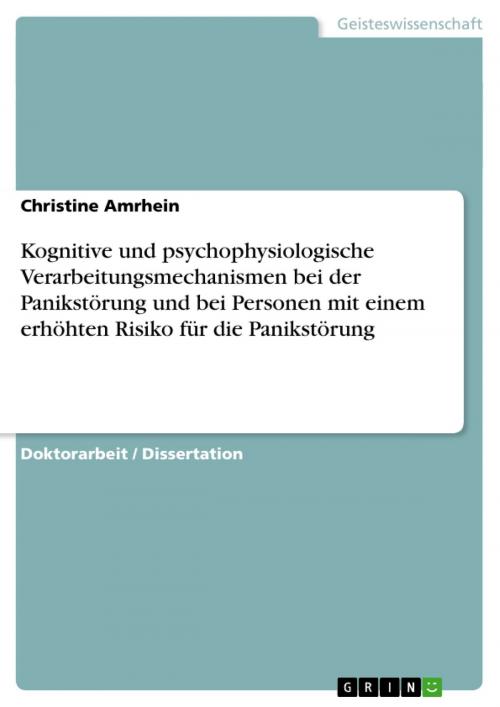Kognitive und psychophysiologische Verarbeitungsmechanismen bei der Panikstörung und bei Personen mit einem erhöhten Risiko für die Panikstörung
Nonfiction, Health & Well Being, Psychology, Physiological Psychology| Author: | Christine Amrhein | ISBN: | 9783640334940 |
| Publisher: | GRIN Publishing | Publication: | May 29, 2009 |
| Imprint: | GRIN Publishing | Language: | German |
| Author: | Christine Amrhein |
| ISBN: | 9783640334940 |
| Publisher: | GRIN Publishing |
| Publication: | May 29, 2009 |
| Imprint: | GRIN Publishing |
| Language: | German |
Doktorarbeit / Dissertation aus dem Jahr 2003 im Fachbereich Psychologie - Biologische Psychologie, Note: Magna cum laude, Eberhard-Karls-Universität Tübingen (Fakultät für Informations- und Kognitionswissenschaften ), Sprache: Deutsch, Abstract: The aim of the present dissertation was to examine particularities in the processing of emotional picture stimuli in panic disorder patients and risk groups for panic disorder. A pre-study with healthy participants showed that their reactions to positive, neutral and negative pictures can be differentiated on the basis of subjective ratings, electrocortical and peripheral physiological measures. Therefore, the first study examined whether subjects at risk for panic disorder (subjects with high anxiety sensitivity (AS), and subjects with high AS and non-clinical panic attacks) differ from healthy controls with low AS in their reactions to emotional stimuli. Aside from positive, neutral and negative pictures, panic-relevant (PR) pictures were presented. Only PR pictures were rated as more negative and more arousing by both groups with high AS, compared to the control group. Subjects with non-clinical panic attacks showed an elevated SCR specifically for PR pictures. For startle reflex and EEG parameters, no differences between groups were found. The results support the idea of an altered processing of PR stimuli in both risk groups; yet, this alteration is more pronounced in subjects with non-clinical panic attacks, and more pronounced for subjective than for psychophysiological measures. As studies have shown that anxiety disorder patients have an elevated expectancy of negative consequences after fear-relevant stimuli, this 'covariation bias' was examined in a further study with panic disorder patients. PR, neutral and phobia-relevant pictures were presented, with half of the pictures of each category being followed by an unpleasant startle sound. Panic patients, as compared to controls, did not show an overestimation of the unpleasant consequence after PR pictures, but revealed a higher CNV amplitude - considered as a psychophysiological indicator of expectancy. These findings indicate that, on a psychophysiological level, panic patients show an altered processing of PR stimuli. Taken together, the studies in this dissertation show that panic patients and individuals with an elevated risk for panic disorder react more intensely to panic-relevant stimuli than healthy controls or individuals with low AS. A direction for future studies could be to examine if these particularities can serve as predictors for the course of panic disorder, for treatment outcome, and for the onset of panic disorder in risk groups.
Doktorarbeit / Dissertation aus dem Jahr 2003 im Fachbereich Psychologie - Biologische Psychologie, Note: Magna cum laude, Eberhard-Karls-Universität Tübingen (Fakultät für Informations- und Kognitionswissenschaften ), Sprache: Deutsch, Abstract: The aim of the present dissertation was to examine particularities in the processing of emotional picture stimuli in panic disorder patients and risk groups for panic disorder. A pre-study with healthy participants showed that their reactions to positive, neutral and negative pictures can be differentiated on the basis of subjective ratings, electrocortical and peripheral physiological measures. Therefore, the first study examined whether subjects at risk for panic disorder (subjects with high anxiety sensitivity (AS), and subjects with high AS and non-clinical panic attacks) differ from healthy controls with low AS in their reactions to emotional stimuli. Aside from positive, neutral and negative pictures, panic-relevant (PR) pictures were presented. Only PR pictures were rated as more negative and more arousing by both groups with high AS, compared to the control group. Subjects with non-clinical panic attacks showed an elevated SCR specifically for PR pictures. For startle reflex and EEG parameters, no differences between groups were found. The results support the idea of an altered processing of PR stimuli in both risk groups; yet, this alteration is more pronounced in subjects with non-clinical panic attacks, and more pronounced for subjective than for psychophysiological measures. As studies have shown that anxiety disorder patients have an elevated expectancy of negative consequences after fear-relevant stimuli, this 'covariation bias' was examined in a further study with panic disorder patients. PR, neutral and phobia-relevant pictures were presented, with half of the pictures of each category being followed by an unpleasant startle sound. Panic patients, as compared to controls, did not show an overestimation of the unpleasant consequence after PR pictures, but revealed a higher CNV amplitude - considered as a psychophysiological indicator of expectancy. These findings indicate that, on a psychophysiological level, panic patients show an altered processing of PR stimuli. Taken together, the studies in this dissertation show that panic patients and individuals with an elevated risk for panic disorder react more intensely to panic-relevant stimuli than healthy controls or individuals with low AS. A direction for future studies could be to examine if these particularities can serve as predictors for the course of panic disorder, for treatment outcome, and for the onset of panic disorder in risk groups.















